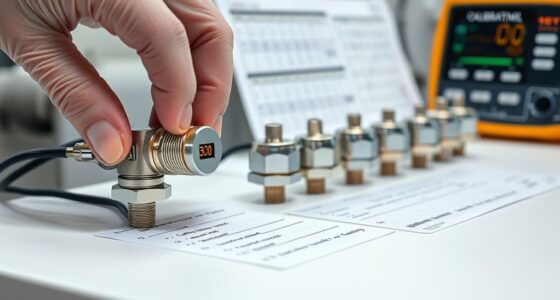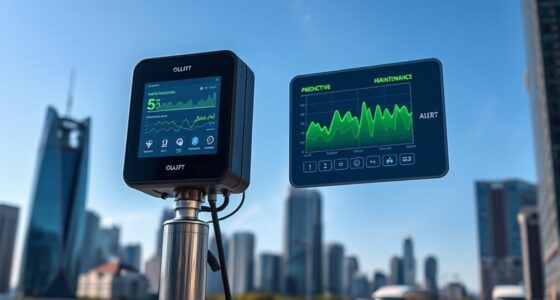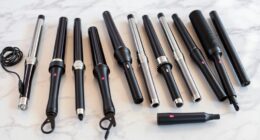Sensor fusion combines PM, VOC, and humidity data to give you a clearer, more accurate view of air quality. By integrating multiple sensors, you can minimize errors and better understand environmental changes. Optimized algorithms analyze this combined data in real-time, helping you detect pollution sources and respond effectively. This approach guarantees your system stays reliable and precise. Keep exploring how these advanced techniques can transform your air quality management efforts.
Key Takeaways
- Sensor fusion integrates PM, VOC, and humidity data to provide a comprehensive view of air quality conditions.
- Combining these data sources enhances accuracy by reducing noise and compensating for environmental variability.
- Algorithm optimization refines the interpretation of multi-sensor data, improving detection of pollution sources and patterns.
- Data fusion enables real-time analysis, supporting timely air quality alerts and decision-making.
- Integrating PM, VOC, and humidity information offers more reliable assessments for environmental monitoring and management.

Sensor fusion is the process of combining data from multiple sensors to create a more accurate and thorough understanding of the environment. When you work with air quality monitoring, integrating data from PM (particulate matter), VOC (volatile organic compounds), and humidity sensors allows you to get a clearer picture of air conditions. This approach isn’t just about collecting data; it’s about intelligently merging different information streams to enhance reliability and insight. By focusing on data integration, you guarantee that the information from each sensor complements the others, reducing noise and discrepancies that could skew results. The goal is to synthesize these diverse data points into a cohesive and meaningful picture of the air quality, which is especially vital when addressing complex environmental factors.
Sensor fusion combines multiple sensors to deliver a clearer, more reliable picture of air quality conditions.
To do this effectively, you need to optimize your algorithms. Algorithms optimization involves refining the computational methods that process sensor data, enabling real-time analysis and more precise readings. Instead of treating each sensor’s output separately, you develop algorithms that weigh and correlate these inputs, recognizing patterns that might be invisible when sensors are viewed in isolation. For example, high particulate levels combined with elevated VOC readings and humidity spikes could indicate specific pollution sources or conditions. By optimizing your algorithms, you reduce false positives, improve detection accuracy, and streamline data processing. This makes your system more responsive and reliable, guaranteeing that you can act on the most accurate information available.
In practice, data integration and algorithms optimization work hand-in-hand. You might use filtering techniques, like Kalman filters or machine learning models, to merge sensor readings while minimizing errors. These methods are designed to adapt to changing environmental conditions, maintaining accuracy even when sensor data fluctuates. When you fine-tune your algorithms, you’re essentially teaching your system how to interpret the combined data more effectively, which leads to better decision-making, whether for air quality alerts or environmental control systems. This process not only enhances sensor performance but also maximizes the value of the data collected, providing a thorough picture that guides actionable insights.
Ultimately, successful sensor fusion hinges on your ability to integrate data seamlessly and optimize algorithms continuously. This guarantees your air quality monitoring system remains precise, responsive, and capable of delivering detailed insights into PM, VOC, and humidity levels. With effective data integration and smart algorithms optimization, you transform raw sensor signals into meaningful information, empowering you to make informed decisions and improve air quality management. This process of data integration ensures that all sensor inputs work together harmoniously, providing the most comprehensive environmental assessment possible.
Frequently Asked Questions
How Does Sensor Fusion Improve Air Quality Assessment Accuracy?
Sensor fusion improves air quality assessment accuracy by combining data from PM, VOC, and humidity sensors, which reduces measurement errors. You perform sensor calibration to guarantee each sensor provides reliable readings and apply data normalization to align different data scales. This process allows you to get a thorough, precise view of air quality, minimizing false alarms and enabling better decision-making for health and safety.
What Are Common Challenges in Integrating PM, VOC, and Humidity Sensors?
They say “a chain is only as strong as its weakest link,” and integrating PM, VOC, and humidity sensors isn’t different. You often face calibration issues that cause inconsistent readings, and data synchronization challenges that lead to timing mismatches. These problems make it tough to get accurate, real-time air quality assessments. To overcome this, you need precise calibration protocols and reliable synchronization methods to guarantee data integrity.
Can Sensor Fusion Algorithms Operate in Real-Time Environments?
Yes, sensor fusion algorithms can operate in real-time environments. You need to guarantee proper sensor calibration to maintain accuracy and implement data synchronization so measurements align correctly. By optimizing these processes, your system can process data swiftly, allowing real-time analysis. This way, you get timely insights, helping you make informed decisions based on combined PM, VOC, and humidity data without delays.
How Do Environmental Factors Affect Sensor Fusion Reliability?
A stitch in time saves nine, and environmental factors can considerably impact your sensor fusion reliability. Humidity interference can distort sensor readings, making data less accurate. Calibration challenges also arise as sensors need regular adjustments to account for changing conditions. These factors can cause inconsistencies, so you should regularly monitor and recalibrate sensors to guarantee your sensor fusion system remains dependable despite environmental fluctuations.
What Are the Cost Implications of Implementing Sensor Fusion Systems?
Implementing sensor fusion systems can be costly due to the need for sensor calibration and data redundancy. You’ll spend more on high-quality sensors to guarantee accuracy and on maintenance to keep calibration precise. Data redundancy requires additional sensors, increasing initial setup costs. However, investing in proper calibration and redundancy improves reliability, reduces false readings, and ultimately saves money by preventing costly errors and ensuring consistent, accurate environmental monitoring over time.
Conclusion
By combining PM, VOC, and humidity data, you gain a clearer picture of your environment’s air quality. Sensor fusion acts like a well-oiled machine, turning separate data streams into actionable insights. Don’t put all your eggs in one basket—integrating multiple sensors guarantees you don’t miss the forest for the trees. Embrace this approach, and you’ll be better equipped to create healthier, safer spaces for everyone.










